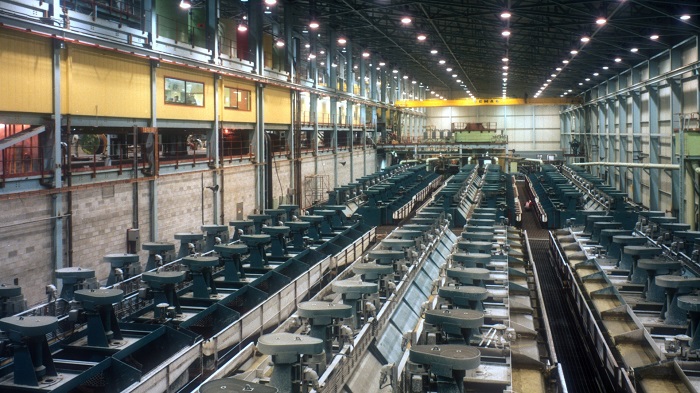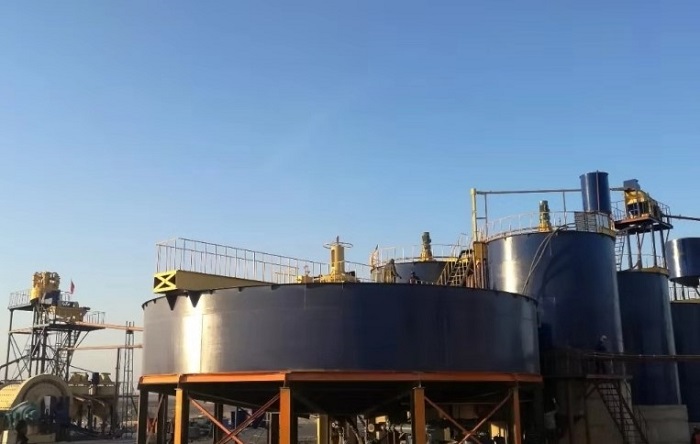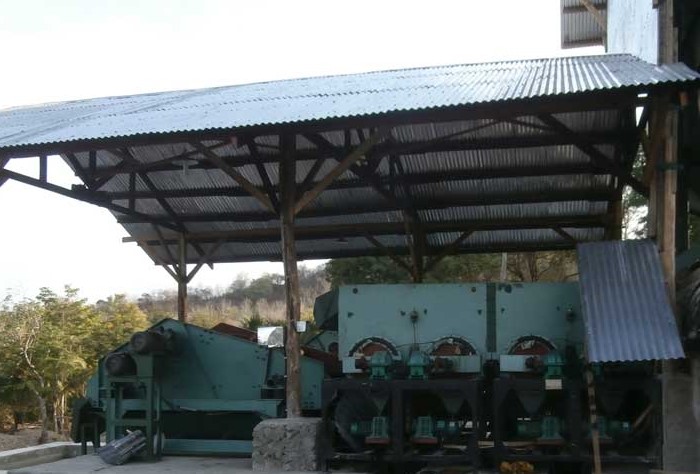At mines, numerous methods are employed to separate and concentrate the ore (beneficiation). The most common methods are flotation, leaching, gravity separation, and solvent extraction. The most widely employed is flotation. For ores of many metals, flotation is used exclusively, for some it is employed in conjunction with another method, most often gravity separation. The most common application for precious metal ores is leaching. Solvent extraction is usually peculiar to uranium ores and copper oxide ores. This chapter further describes flotation, leaching of precious metals, and gravity separation. Solvent extraction is dealt with only as it relates to the recovery of copper.
Flotation
Due to surface tension, a tiny flake of gold can float in a glass of water despite the fact that gold is almost twenty times as heavy as water. If the water is stirred vigorously with a spoon after a few drops each of pine oil and creosote (reagents) are added, a minute (<75m) gold particle will usually rise and float in the thin surface foam (froth). This occurs because gold is naturally hydrophobic (not wetted by water) and because the reagents make the tiny gold particle more water-repellant and bubble attractive. Commercial flotation exploits and enhances this phenomenon to float (and skim off) fine particles of gold in unusual circumstances, such as when fine gold is contained in a cyanogenic (over-oxidized) gangue or freely associated with other minerals (to be recovered by the same process).

Base metal minerals are much more amenable than gold to this same procedure and they constitute by far the most common application for recovery by flotation. These minerals (usually sulfides) occur as particles (separated by the grinding process) that are recovered by the same process of flotation from “pulp” (a mixture of finely ground ore and water).
In some cases, flotation is used to remove an unwanted mineral component from the pulp.
Reagents usually work better in an alkaline pulp; therefore, a pH regulator (usually lime) is typically added before the reagents are meted out. The reagents used are mainly the following proprietary chemical compounds.
1.A frother (pine oil is a simple frothing agent with some collecting powers)
2. A collector and promoter (combined in one agent or provided separately)
3.A modifier (which may have one of any number of functions)
Air is a necessary component of the flotation procedure. Slightly compressed air is blown into the flotatiion machine providing agitation and a thicker froth (bigger bubbles). Some mills once employed simple mechanical agitation (analogous to stirring with a spoon), because too much air was deemed detrimental to flotation efficiency in their particular case.
Selective flotation refers to floating one mineral while leaving behind (depressing) another. Differential flotation refers to selective flotation of different economic minerals in succession from a poly-metallic ore.
In an elementary flotation circuit, the pulp is “conditioned” with reagents before flowing continuously through one bank of cells (tier of connected, open tanks) and then to another bank. The float is continuously skimmed off in each cell. The skimmed float from the first stage of cells (roughers) is typically combined with float from a second stage (scavengers) and directed to a third stage (cleaners) where it is re-floated to produce a slurry of nearly pure mineral (concentrate or “cons”). The slurry is subsequently dewatered and dried to make the final concentrate that is then suitable as smelter feed.
The barren pulp (“tails”) from which the mineral has been won is partially dewatered and piped from the mill for further dewatering and permanent disposal in a tailings impoundment or sometimes used as backfill in empty underground stopes (as a component of paste fill or hydraulic fill).
In new mills, the flotation cells are larger (the silting problem having been solved). Often, the traditional rectangular tank cells in the cleaning phase are replaced with erect cylindrical tanks (column flotation). These advances save space, facilitate monitoring, and reduce maintenance costs; however, there is a practical limit to the size of cells to prevent short-circuit and maintain flexibility. The larger the mill capacity, the larger the cells.
As is the case with grinding, modern flotation circuits are equipped with computerized controls to regulate and monitor variables, such as grind, pH, reagent feed, conditioning residence time, cell retention time, and pulp density.
Leaching of Precious Metals
Mines most often separate and recover noble metals, such as gold (and the silver that is normally found with the gold) by gravity and/or cyanide leaching.
Gravity concentration is used almost exclusively when placer mining. Some hard rock mine mills use gravity as a preliminary step in the recovery procedure, but for many it is either inefficient (because of minute gold particle size) or not desired (because it is perceived to facilitate theft).
In the normal (free milling) process, the ground ore is treated (leached) with a dilute alkaline (high pH) solution of sodium cyanide (NaCN). The solution is made alkaline with addition of generous quantities of hydrated lime (quick lime). The cyanide reacts chemically with the gold to form a soluble compound, Au(CN)2. The solution containing gold is called pregnant or simply “preg.”
Subsequently, the pregnant solution may be clarified and the gold directly precipitated with zinc powder (traditional Merrill-Crowe process). The precipitate is then filtered (pressed) and then the compacted precipitate is smelted on-site to produce bars of bullion.
More commonly, the Au (CN)2 is adsorbed by pellets of activated carbon that are later separated by screening. The pellets are then flushed with a hot (230-266 degrees F) alkaline cyanide solution to dissolve (strip) the gold. The dissolved gold is typically recovered from the resulting rich solution by electrolysis (“electrowinning”).
The cyanide solution from which the gold was precipitated (or the loaded carbon was separated) is termed barren and is recycled. So are stripped carbon pellets (which are first re-activated in a kiln).
When the loading of the carbon takes place subsequently and separately from leaching, the process is called CIP. Loading coincident with leaching (short circuit) is called CIL.

Some gold ores are not free milling. In rare instances, the gold in the ore is found to be chemically combined (tellurides) and more commonly found locked into sulfide crystals (“refractory”). Refractory ores are amenable to flotation and the concentrate.obtained then subjected to a process (roasting, biological leaching or autoclaving) that reduces the crystalline sulfides to oxides that may subsequently be efficiently leached with cyanide.
Cyanide was the leaching agent of choice for a century despite the fact that it is expensive and lethal if swallowed. Substitutes exist, but none have thus far proven effective and practical. Cyanide is at least 1,000 times more toxic to fish than it is to humans and animals. Dead fish in a river after an accidental spill does not mean the water is poisonous to other fauna. Only one recorded accidental fatality occurred from cyanide poisoning in the mining industry in the whole of the 20th century.
Nevertheless, cyanide is now outlawed or otherwise forbidden in some jurisdictions and this may be the beginning of an unfortunate trend. The good news is that some trees (willow family) thrive on a weak cyanide solution. Very efficiently, they consume it like fertilizer and turn it into an essential amino acid (asparagine). Research continues.
Gravity Separation
Gravity separation is the oldest and apparently the simplest means of concentrating ores. Gravity separation is often defined as the separation of coarse particles of metal or mineral; however, this is not always the case. Artificial gravity (centrifugalforce) can enable the separation of fine particles in a centrifuge or hydrocyclone.

To comprehend gravity separation, it is necessary to understand that a difference in weight alone (differential SG) is not the only consideration for separation in a dynamic process. Particle size plays an equally important role, as does the medium in which the particles are suspended (air, water, brine, or heavy media). A dense particle (high SG) of tiny size may have the same amount of movement in a fluid media as a different larger particle that is lighter (lower SG). It follows that for a difference in specific gravity to be effective, all the particles should be nearly the same size. Conversely, artificial gravity may be employed to separate particles of similar specific gravity but different particle size (“classification”). This is the operating principle of the hydro-cyclone classifier that re-circulates the coarse fraction of ground pulp back into a ball mill.
Besides centrifuges and cyclones, all sorts of machines are used for gravity separation, including sluices, jigs, cones, shaking tables, spiral chutes, and heavy media separation etc.
Solvent Extraction (SX) for Copper Recovery
When a long abandoned underground copper mine is dewatered, a strange phenomenon may be observed. Pieces of miningequipment left behind (such as an old mine car) have turned into to what appears to be pure copper! (Actually, the purity is around 70%.) Remnant sulfides made the mine water acid (sulfuric acid) that in turn “dissolved” remnant copper ore that resulted in a solution containing copper sulfate (CuSO4). Since copper ions have a higher valence than iron, the metal equipment was in turn gradually “dissolved” and replaced by deposition of copper. This is the essence of solvent extraction and recovery.
Today, Chile is known for its huge open-pit copper mines, but at one time, much smaller underground operations prevailed. In fact, the mining areas are riddled with long abandoned minesites. About twenty-five years ago, some enterprising mining personnel initiated a popular weekend pastime. After locating a waste rock dump (that contained some ore) they would leach it with sulfuric acid and direct the drainage to a pit they filled with scrap iron. On the weekends, they would recover the copper that replaced the iron and sell it for a handsome profit.
Then, a mining company researched the procedure and came up with a method that recycled the reagents and eliminated the obvious environmental problem. They neutralized the acid leach solution and added a special type of kerosene that “extracted” the dissolved copper sulfate in a “mixer-settler” arrangement. The loaded kerosene was then easily separated (since it is lighter than water). In a subsequent process, the copper was “stripped” from the kerosene into another acidic solution (and the kerosene recycled). This solution was directed to a tank house where it was deposited on thin copper plates to produce thick copper plates (“cathode copper”) that were almost 100% pure. This refining process is termed “electro-winning” (EW), and the whole procedure is called SX-EW.
SX-EW was then applied (with great success) to low-grade waste heaps at large open pit operations and later to a huge new mining project.
Today the procedure of solvent extraction is a highly developed (and complicated) science resulting in a very efficient process that optimizes recovery and produces copper that is 99.9% pure.